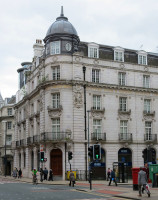
Leeds has much by way of decorative architectural sculpture, and the Scottish Union and National Insurance Company Building is an outstanding example among strong competition. It stands at 26, Park Row, among a variety of impressive buildings, a white block, four storeys high with a little turret and dome at the corner, and parallel dormer windows forming a shallow fifth floor: the ground and first storeys are taller than those higher up. The whole building is clad in white glazed tile, of a brand called ‘Marmo’ produced by the famous local firm trading as the Leeds Fireclay Company, of Burmantofts, Leeds from late Edwardian times. Marmo was marketed as ‘closely resembling white marble’, and competed directly with Doulton’s equivalent product called Carraraware (Carrara of course being the origin and name of the most familiar white marble favoured by sculptors). Such tile cladding is particularly prevalent in Leeds, and Manchester, but in London is much less familiar with the exception of the Metropolitan Line stations, in a dark burgundy tone, and the odd Carraraware building such as the Savoy in the Strand, London. Glazed tiles were seen as being both beautiful and easy to clean, and unlike some materials, stood up well to the pollution found in city centres from acid smog from coal burning, and, later, cars.
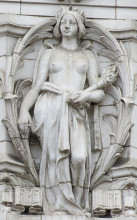
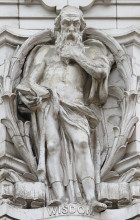
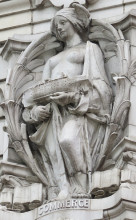
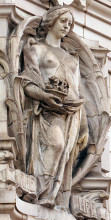 Allegorical Figures by Joseph Thewlis.
Allegorical Figures by Joseph Thewlis.
The principal sculptural decoration of the Park Row building, at second floor level, consists of four full-sized figures, three on the frontage to Park Row, one round the corner in South Parade. The single male figure, an aged, heroic man, semidraped, is entitled Wisdom. He stands in relaxed pose, one hand holding an open book, the other stroking his beard, as if deep in contemplation of something he has read. Also on the side facing Park Row, there are two female semidraped figures. The first is Commerce, who holds a small ocean liner in her hands. She, like the other figures, is not quite an angel, but is contained within an enfolding wreath suggestive of wings; she also has small wings attached to her hair, indicative of a Messenger role. Her torso is bare, but she has a heavy cloak draped over a shoulder, and further drapery over her legs, rather sketchy in detail. The second figure, an allegory of Fire and Life Insurance, holds a sculpture of a little crocodilian dinosaur, unfortunately rather damaged. She too has a cloak, and some thin shirt with a crossed strap between her breasts. The drapery across her legs is perhaps better worked out than that of the figure of Commerce. Our third female figure, facing across South Parade and thus along Park Row, is another version of Fire and Life Insurance, differing in her drapes, and holding a flaming torch. She wears a crown. Each figure is signed by the sculptor, J. Thewlis.
The building also has, pairs of seated caryatid figures (supporting figures in place of a pillar or bracket) as supports to the second floor balconies all the way round the three open sides. All the pairs are identical, but the left hand and right hand figures within each figure differ. They are charming slender maidens, semidraped, with downturned faces and of the variety of caryatid supporting the weight above on their crossed arms above the head. For more on caryatids see this page.
Between the figures in the picture, we see a wreath which bears within it a low relief of some dinosaur in a leafy environment, with perhaps a sunburst behind.
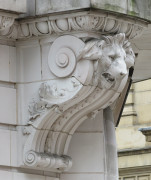
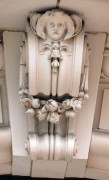 Brackets showing lion's head and head of a girl
Brackets showing lion's head and head of a girl
Brackets at first floor level bear sculptured lion heads, rather naturalistic, especially about the eyes and muzzle, and little artsy-craftsy heads of children or young females, with buds and fruit below. Among various more minor Edwardian baroque decoration on the building, we may note particularly garlands of flowers and fruit each with a rams’ head at the top. More on sheep sculpture on this page; and lions on this page.
The Scottish Union and National Insurance Company had been created as a merger between two Scottish insurance companies in the 1870s, and was bought up by the acquisitive Norwich Union in 1959. This building, dating from 1909, and one of several the company built, though the only one I have noted with this sort of sculptural decoration, was the design of Perkin and Bulmer.
This page was originally part of a 'sculpture of the month' series, for July 2013. Although the older pages in that series have been absorbed within the site, if you would wish to follow the original monthly series, then jump to the next month (August 2013) or the previous month (June 2013). To continue, go to the bottom of each page where a paragraph like this one allows you to continue to follow the monthly links.
Leeds City Square // Leeds Town Hall
Sculpture in England // Sculpture pages
Visits to this page from 1 Jul 2013: 6,218